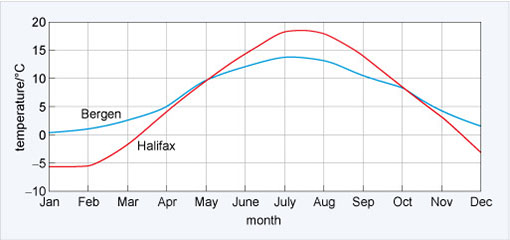1 The effect of the oceans on climate
You can see the effect of the oceans on regional climate by looking at the annual cycle of monthly air temperatures at two coastal locations at different latitudes. You might expect that the closer to the Equator, the warmer it would be. But is this the whole story?
Figure 1 shows the relative locations of Bergen, Norway (60° N, 5° E) and, 1700 km closer to the Equator, Halifax, Nova Scotia (44° N, 63° W). As it is further south you might expect Halifax to be much warmer than Bergen. But you can see in Figure 2 that this is not the case.

-
What are the main differences between the atmospheric temperature cycles of Halifax and Bergen?
-
Halifax is warmer than Bergen in summer, but colder in winter.
The range between the maximum and minimum temperatures is also different; in Halifax it is ~24 °C (-6 °C to +18 °C), whereas in Bergen it is ~12 °C (~0 °C to +12 °C). It is only from May to the end of September that Halifax is warmer than Bergen. This arises because a vast quantity of heat is being supplied by the ocean. You can see this heat in Figure 1 because the colours representing equal sea surface temperature are not along lines of equal latitude. North of the Spanish coast water temperatures are warmer on the east side than the west. And it is a remnant of a warm water current called the Gulf Stream which flows across the Atlantic Ocean towards Northern Europe.
In subsequent sections you will see that the shape of the ocean basins (Section 2) combined with the properties of seawater (Section 3) and the ocean currents (Section 4) and the cryosphere are responsible for the Gulf Stream.
So far, you have seen how the oceans can influence regional climate. In the following sections you will investigate the reasons for this in more detail.

